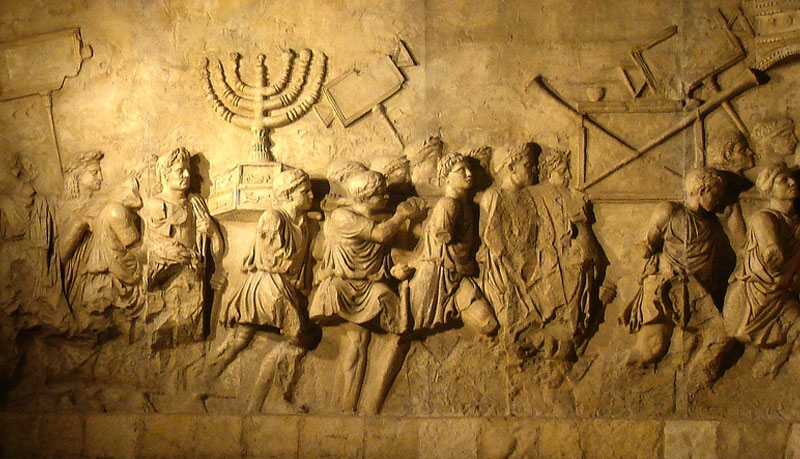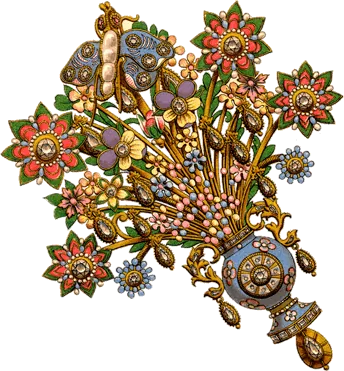Seven branches - seven lights. Seven is significant. Seven is a recurring number in Scripture. It is associated with completion and perfection.
Did you know that a vast majority of the gospel accounts of Yeshua's life occur in and around the Temple? With this being the case, could it be that possessing knowledge of the Temple and its furnishings can secure for us a deeper understanding of Yeshua and his teachings?
One such account appears in John 8:12: 'When Yeshua spoke again to the people, he said, "I am the light of the world. Whoever follows me will never walk in darkness but will have the light of life."'
Yeshua: "Light of the World"
This powerful declaration was issued by our Messiah as he visited the Temple during the Feast of Sukkot, better known as the Feast of Tabernacles. The Feast of Sukkot was also known as the Festival of Nations. The Temple, itself, was called "the light of the world." This is confirmed in the writings of the Talmud: (Baba Bathra 4a.6) "Go now and attend to the Light of the World [which is the Temple, of which] it is written, 'And all the nations become enlightened by it.'"
Now if the Temple was called "the Light of the World", and if Yeshua uttered his proclamation in the backdrop of the Temple, then can we not safely assume that Yeshua was comparing himself to the Temple?
To understand this more fully let us consider the Seven Branch Menorah-the main source of light for the Holy Place of the Temple. This light emanated from seven oil lamps, each on one of seven branches. The center branch or lamp was called Neir Elohim , translated "the Light of God". As seen in the diagram there were three branches on each side of the Neir Elohiem.
The instructions for the specific design of the Menorah were given by God to Moses in Exodus 25.
"Make a lampstand (menorah) of pure gold and hammer it out, base and shaft; its flowerlike cups, buds and blossoms shall be of one piece with it. Six branches are to extend from the sides of the lampstand, three on one side and three on the other. Three cups shaped like almond flowers with buds and blossoms are to be on one branch, three on the next branch, and the same for all six branches extending from the lampstand. And on the lampstand there are to be four cups shaped like almond flowers with buds and blossoms. One bud shall be under the first pair of branches extending from the lampstand, and a second bud under the second pair, and a third bud under the third pair, six branches in all. The buds and branches shall all be of one piece with the lampstand, hammered out of pure gold. Then make its seven lamps and set them on it so that they light the space in front of it. Its wick trimmers and trays are to be of pure gold. A talent of pure gold is to be used for the lampstand and all these accessories. See that you make them according to the pattern shown you on the mountain." (Exodus 25:31-40)
Seven branches-seven lights. This number seven is significant. Seven is a recurring number in Scripture. It is associated with completion and perfection. In this case it teaches us that the light emanating from the Menorah was a perfect light.
We have established that the Temple was called the light of the world. If, therefore, the perfect light emanating from the Temple shone from the Menorah, Yeshua, by comparing himself to this light, was telling us that he is the perfect light. And what is this perfect light? It is the light of the world that will lead us to the light of life: eternal life-that is the resurrection.
Why do you suppose God instructed Moses to include almond flowers, buds, and blossoms in the design of the Menorah? Because the almond tree, the first tree to blossom in Israel's spring season, is God's illustration of resurrection. (You may recall that Aaron's rod, a dead stick, came to life with almond blossoms).
As with the branches of the Menorah, so it is with the almond blossoms and buds; there are seven of each. Why were there seven?
To answer this question, let us refer to the account of creation which is the first citation of the number seven in Scripture. God created the earth in six days and rested on the seventh day, and the cycle of seven began again. Peter tells us that the days of creation represent a pattern for the entire amount of time which God created from the beginning. He tells us that with the Lord a day is as a thousand years, and a thousand years are as a day. I refer to 2 Peter 3:7-9: "By the same word the present heavens and earth are reserved for fire, being kept for the day of judgement and destruction of ungodly men. But do not forget this one thing, dear friends: with the Lord a day is like a thousand years and a thousand years are like a day. The Lord is not slow in keeping his promise, as some understand slowness. He is patient with you, not wanting anyone to perish, but everyone to come to repentance."
Each day of creation is a picture of a thousand years. There will be a total of six thousand years of the present age, and then we will arrive at the Coming Age or the Messianic Age which will last a thousand years.
Paul spoke of these two ages in 1 Timothy 6:19: "In this way they will lay up treasure for themselves as a firm foundation for the coming age, so that they may take hold of the life that is truly life."
Paul again refers to these two ages in Ephesians 1:19-21: "and his incomparably great power for us who believe. That power is like the working of his mighty strength, which he exerted in Christ when he raised him from the dead and seated him at his right hand in the heavenly realms, far above all rule and authority, power and dominion, and every title that can be given, not only in the present age but also in the one to come."
God's seven-thousand-year plan-God's unique seven-branch design for the Menorah: this is God's perfect plan and his perfect design displayed in his number of perfection and completion.
Not only do each of the seven branches represent a thousand years in God's plan, but we can be more specific in saying that each branch of the Menorah represented the people of God in each of those one-thousand-year periods. During each of those six millennia lived people of God who by the Holy Spirit (exemplified by the oil of the lamps) were the light of God in the world. Just as the outer lamps of the Menorah faced the Neir Elohiem, these people turned their hearts toward God and witnessed to the world the light of God---the Messiah.
These were people like Abraham who knew a redeemer was coming. And he knew that God, himself, would provide that redeemer. That is exactly what he told his son Isaac on the day he offered him to God. The Torah tells us: "Abraham took the wood for the burnt offering and placed it on his son Isaac, and he himself carried the fire and the knife. As the two of them went on together, Isaac spoke up and said to his father, 'Father?' 'Yes, my son?', Abraham replied. 'The fire and wood are here,' Isaac said, 'but where is the lamb for the burnt offering?' Abraham answered, 'God himself will provide the lamb, my son.' And the two of them went on together." (Genesis 22)
Yeshua referred to this very account in John 8:56: "Your father Abraham rejoiced to see my day, and he saw it, and was glad."
These were people who, by faith, were lights to the world. The book of Hebrews speaks of these witnesses in Chapter 11-people like Able, Enoch, Noah, Abraham, Sarah, Jacob, Joseph, Gideon, Barak, Samson, Jephthah, David, Samuel, and the prophets. Then in Hebrews l2:1-2 we are told: "Therefore, since we are surrounded by such a great cloud of witnesses, let us throw off everything that hinders and the sin that so easily entangles, and let us run with perseverance the race marked out for us. Let us fix our eyes on Jesus, the author and perfecter of our faith, who for the joy set before him endured the cross, scorning its shame, and sat down at the right hand of the throne of God."
These were men and women who in each millennia turned their faces, as it were, toward God, even as the six outer lamps of the Menorah face the Neir Elohiem-the light of God.
In that seventh and center branch of the Menorah-God's perfect light-we see a picture of the seventh millennium when there will be no need for witnesses. During this time the true light of God will reside here in this world. Our Messiah Yeshua will return to rule the world.
God's seven-thousand-year plan was also perfectly portrayed in the lighting of the Menorah each year on the Festival of Yom Kippur. On this day alone the High Priest performed the entire Temple Service which included the lighting of the lamps. Four of the lamps were lit before Ketores or the offering of the incense and the daily prayers followed by the lighting of the two remaining lamps. Remembering that each of the lamps represents one thousand years in God's plan, consider that there were four thousand years before the coming of Messiah. The first four lamps lit represent those four thousand years.
Of what significance is the order of lighting-four lamps lit and then the incense? Messiah was the sweet aroma of incense to God; Messiah made intercession for the world before he offered himself in the fourth millennium. And the lighting of the last two lamps corresponds to the two millennia after Messiah's offering at the end of which all will be complete.
God designed his plan for a purpose, and that purpose fully involves those who follow Yeshua. Remember our initial scripture in John 8:12? Yeshua compared himself to the Temple and to the Menorah by which he has established himself as the light of the world, the light of life, the perfect light. He said, "…whoever follows me will never walk in darkness but will have the light of life." Whosoever follows him……this makes reference to those who have turned their full attention toward him.
In Matthew 5:14-16 Yeshua says: "You are the light of the world. A city on a hill cannot be hidden. Neither do people light a lamp and put it under a bowl. Instead they put it on its stand, and it gives light to everyone in the house. In the same way, let your light shine before men, that they may see your good deeds and praise your Father in heaven."
Did Yeshua then refer only to himself as the light of the world? No! He included his followers. He is the light who draws others to his light, and they in turn become lights!
The Menorah's almond blossoms are symbols of the reward his followers will receive. They will be resurrected to be with the Messiah for all eternity!
In Isaiah 26:19 God assures us of this very resurrection: "Your dead shall live. My dead bodies shall arise-awake and sing you who dwell on the earth! For your dew is as the dew of light and the earth shall cast out the dead…"!!
Yeshua is indeed the light of the world! Let us, too, be lights!


